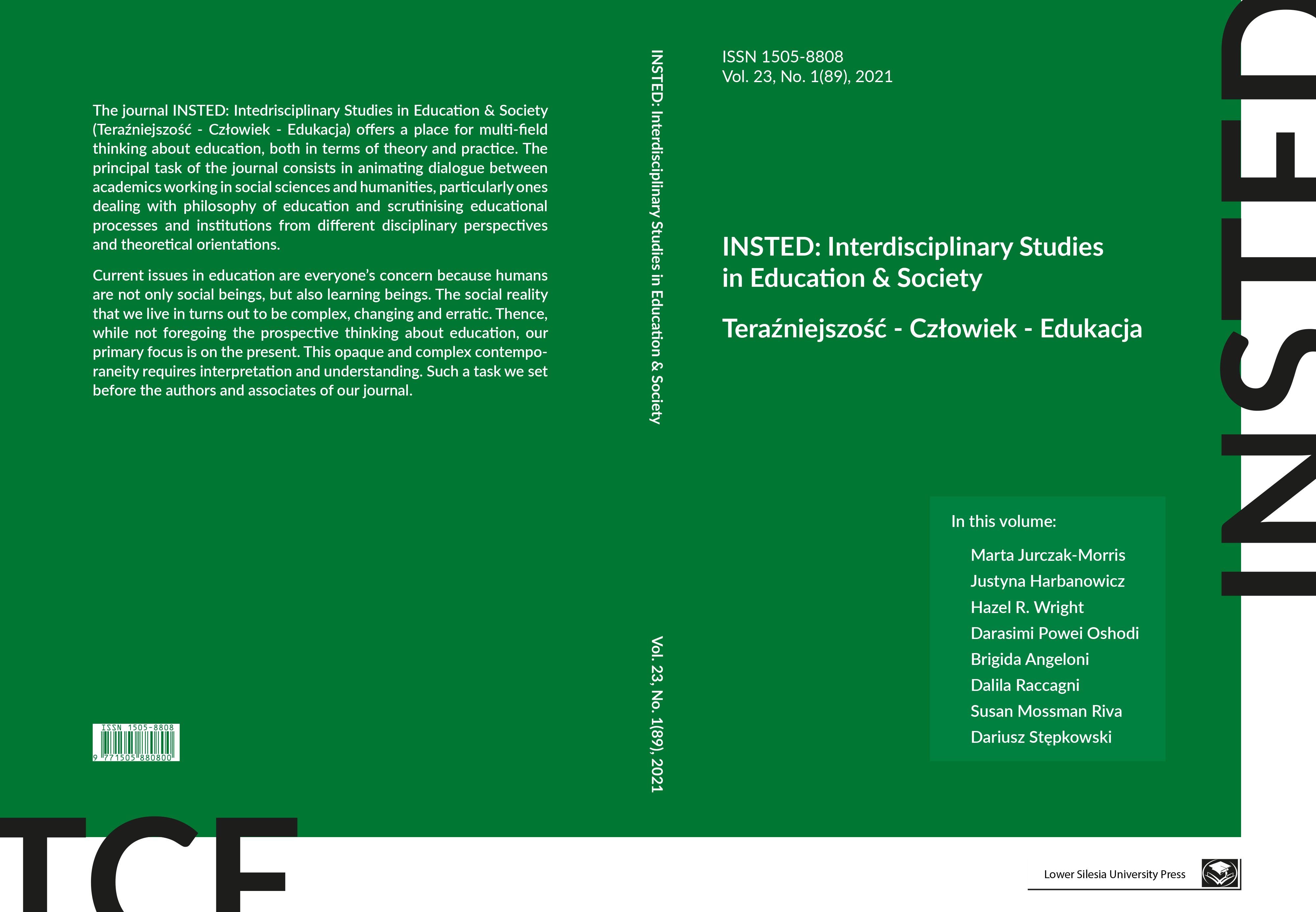Main Article Content
Abstract
School, like a social melting pot, is a space for diverse interactions and behaviours, often of quite a different nature. The aim of this text is to look at the ways in which pupils from varying social backgrounds interact with the school world as well as to explain the logic behind their behaviour. Pierre Bourdieu, whose theoretical approach forms the basis of my research, has dichotomised these types of interactions as ‘pedantism’, a characteristic of the so-called ‘humble pupils’, and ‘self-confidence’, that of the so-called ‘worldly pupils’ (‘mondains’), highlighting the fundamental differences in their modality to culture and language, manifested in their different ways of being and reacting within the school world. This text discusses these various ways of interaction with and at school based on pupils’ social class affiliation, highlighting specific situations from school life to illustrate the Bourdieusian theory of capital and habitus.
Keywords
Article Details
Copyright (c) 2021 INSTED: Interdisciplinary Studies in Education &Society

This work is licensed under a Creative Commons Attribution-ShareAlike 4.0 International License.
TCE (INSTED) is an open access journal, which means that access to the full texts is free of charge. People using the journal may download publications, copy and print them, as well as post on their websites links to the full texts of the journal's publications. Texts can be used as long as readers do not exceed the licenses. Authors submitting manuscripts for publication obtain copyrights. Unless otherwise specified, published texts are available under the Creative Commons Attribution - Share Alike 4.0 International license.
References
- Babbie, E. (2005). Social research in practice. PWN.
- Babbie, E. (2008). Fundamentals of social research. PWN.
- Bourdieu, P. (1986). The forms of capital. In J. Richardson (Ed.), Handbook of Theory and Research for the Sociology of Education, pp. 241-258. Greenwood.
- Bourdieu, P. (1990). The logic of practice. Polity Press.
- Bourdieu, P. (2005). Distinction. A social critique of the power of judgment. Scholar.
- Bourdieu, P., & Passeron, J-C. (2006). Reproduction. Elementy teorii systemu nauczania. PWN.
- Bourdieu, P., & Wacquant, L.J.D. (2001). Invitation to reflexive sociology. Oficyna Naukowa.
- Brewer, J. (2000). Ethnography. Open University Press.
- Czerepaniak-Walczak, M. (2015). School culture - about its complexity and multidimensionality, Social Pedagogy. Fundamental Issues (3)57, 77-87.
- Dunne, M., & Gazeley, L. (2008). Teachers, social class and underachievement. British Journal of Sociology of Education, Vol 29, 1-13.
- Gdula, M. (2017). The benefits of classism. Classes in Poland and the chances of social change. In M. Gdula & M. Sutowski (Eds.), Classes in Poland. Theories, discussions, research and contexts, pp. 135-162. Institute for Advanced Studies.
- King, A. (2000). Thinking with Bourdieu against Bourdieu: A ‘practical’ critique of the habitus. Sociological Theory,18, 417-433.
- Kwieciński, Z. (2009). Liberty or equality in education? In A. Męczkowska-Christiansen & P. Mikiewicz (Eds.), Ideas-diagnosis-hopes. Polish school and the ideas of equality, pp. 19–24. DSW.
- Lareau, A. (2003). Unequal childhoods: Class, race and family life. University of California Press.
- Leathwood, C., & Archer, L. (2006). Social class and educational inequalities: The local and the global. Pedagogy, Culture and Society, Routledge, 1-11.
- MacLeod, J. (2018). Ain’t no making it (3rd edition), Routledge.
- Merton, R. K. (1982). Sociological theory and social structure. PWN.
- Mikiewicz, P. (2007). Social selection and segmentation as an immanent function of the education system. In J. Klebaniuk (Ed.), The phenomenon of social inequalities, pp. 67-82. Eneteia.
- Mikiewicz, P. (Ed.), (2011). Social capital and education. Comparative research between Poland and Iceland. Final report. DSW.
- Mikiewicz, P. (2005). The social worlds of secondary schools. From trajectories of the margins to trajectories of the elites. DSW.
- Spradley, J. P. (1979). The ethnographic interview. Holt, Rinehart and Winston, pp. 937-938.
References
Babbie, E. (2005). Social research in practice. PWN.
Babbie, E. (2008). Fundamentals of social research. PWN.
Bourdieu, P. (1986). The forms of capital. In J. Richardson (Ed.), Handbook of Theory and Research for the Sociology of Education, pp. 241-258. Greenwood.
Bourdieu, P. (1990). The logic of practice. Polity Press.
Bourdieu, P. (2005). Distinction. A social critique of the power of judgment. Scholar.
Bourdieu, P., & Passeron, J-C. (2006). Reproduction. Elementy teorii systemu nauczania. PWN.
Bourdieu, P., & Wacquant, L.J.D. (2001). Invitation to reflexive sociology. Oficyna Naukowa.
Brewer, J. (2000). Ethnography. Open University Press.
Czerepaniak-Walczak, M. (2015). School culture - about its complexity and multidimensionality, Social Pedagogy. Fundamental Issues (3)57, 77-87.
Dunne, M., & Gazeley, L. (2008). Teachers, social class and underachievement. British Journal of Sociology of Education, Vol 29, 1-13.
Gdula, M. (2017). The benefits of classism. Classes in Poland and the chances of social change. In M. Gdula & M. Sutowski (Eds.), Classes in Poland. Theories, discussions, research and contexts, pp. 135-162. Institute for Advanced Studies.
King, A. (2000). Thinking with Bourdieu against Bourdieu: A ‘practical’ critique of the habitus. Sociological Theory,18, 417-433.
Kwieciński, Z. (2009). Liberty or equality in education? In A. Męczkowska-Christiansen & P. Mikiewicz (Eds.), Ideas-diagnosis-hopes. Polish school and the ideas of equality, pp. 19–24. DSW.
Lareau, A. (2003). Unequal childhoods: Class, race and family life. University of California Press.
Leathwood, C., & Archer, L. (2006). Social class and educational inequalities: The local and the global. Pedagogy, Culture and Society, Routledge, 1-11.
MacLeod, J. (2018). Ain’t no making it (3rd edition), Routledge.
Merton, R. K. (1982). Sociological theory and social structure. PWN.
Mikiewicz, P. (2007). Social selection and segmentation as an immanent function of the education system. In J. Klebaniuk (Ed.), The phenomenon of social inequalities, pp. 67-82. Eneteia.
Mikiewicz, P. (Ed.), (2011). Social capital and education. Comparative research between Poland and Iceland. Final report. DSW.
Mikiewicz, P. (2005). The social worlds of secondary schools. From trajectories of the margins to trajectories of the elites. DSW.
Spradley, J. P. (1979). The ethnographic interview. Holt, Rinehart and Winston, pp. 937-938.




